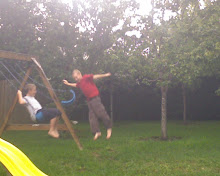Well, I think I'm finally finished with doctors. We've been seeing a very good Neurologist. Over the past month, I've been going to get even more tests done. I've had 2 MRIs, an EMG test, blood tests, reflex tests, and we've transferred our doctor all the records from other doctors I have seen, including the Endocrinologist I saw last year. Unfortunately, after all of the testing, the Neurologist gave us the same answer that the Endocrinologist did last year... that there's something wrong with me, but they're not exactly sure what.
When I last wrote on this topic, I had old information, and now I have new. At the time, I told you that I had cerebral palsy. I, indeed, had been told that I did, but that was a long time ago. However, doctors I've been seeing these past few months have now ruled out cerebral palsy. I guess it was easier to see what I have/don't have now that the symptoms are worse. My current neurologist says that it is some sort of neuromuscular disease, though he doesn't know exactly which one. My muscles are fine, but they have found atrophy in my spinal cord, which explains the loss of movement. I still have almost complete sensation in my legs and torso, so that is great. This is because my spinal cord damage is on the inside of the tract, where the nerves go down to the legs, whereas the outside of the tract, where the nerves send sensation up to the brain, is mostly unaffected.
It could be Hereditary Spastic Paraplegia, which fits my symptoms perfectly, or if not, it's something similar to it. Our doctor has told us that there are cases like mine in which you can find what's going wrong, you just can't find what caused it in the first place. He says that happens a lot in neurology. I guess it's a complicated field of study, with nerves being so small and all. :-)
As for a prognosis, I'm expected to stay the same. It's possible that it could get worse in a decade or two; we just don't know until it happens. At least I won't get any worse for a while. That's fine with me. Staying the same is better than the quick changes I went through at the beginning of the year. I'm so happy to just stay where I am, so I'm glad that's what we were told to expect. So, that's it.
I'm glad that Brian and I have adapted to our life. It looks like there isn't any sort of treatment or medicine available for me, even if I was completely diagnosed. Nothing that could help me walk better. The doctor did offer botox shots to help with the muscle spasms in my legs, if I am interested. But I'm really keeping that controlled with lots of yoga, but there's nothing that can be done about the too-weak muscles.
That's the story. I wanted to let you all know what we had learned. Oh, and by the way, I finally got around to getting a disabled parking permit. Yay! That's been really nice! It's nice not living in fear that someone will park too close to the driver's side of my car and I won't have room to roll up to the door and disassemble my wheelchair. Now I feel much more taken care of.
Last Sunday, at church, all of the disabled spots were taken, so I parked far away in the back, and I parked in the middle of two parking spots, so that I would have the extra room I need on the driver's side of the car. I hoped no one would mind, but I also hoped that my disabled plates and the full disabled parking section gave me the permission to take up two spots. No one complained, so I guess it was okay. :-)
We got handicapped plates put on my car, and there's a rear-view-mirror placard we can use when I'm in someone else's car. About two months ago we had hand controls installed in my van, which are wonderful. Let's see, what else... all of the plates and cups have been moved lower in the kitchen, the boys are getting good at doing all of their new chores, we have a stair lift chair and a second wheelchair for upstairs, and a ramp to get down to the garage which is one step down.
I've learned how to open any door and get through it by myself. And I got some wide and cushiony tires on the front of my wheelchair, so now I can go over dirt, grass, and occasional rocks just fine. So, life is all settled once again. I'm so glad that this crazy summer is over.
Alaska to California: The last chapter
6 years ago




